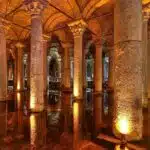
Significance of the Basilica Cistern in Istanbul’s Cultural Landscape
The Basilica Cistern (Yerebatan Sarnıcı) is more than just an architectural marvel — it’s a living memory of Istanbul’s layered identity, blending ancient heritage with modern cultural relevance. As one of the city’s most iconic underground landmarks, it has shaped everything from artistic imagination to tourism economics. In this post, we explore the enduring significance of the Basilica Cistern across different historical and cultural timelines.
Connection to the City’s Byzantine Past
Constructed in the 6th century under Emperor Justinian I, the Basilica Cistern represents one of the most advanced water management systems of the Byzantine Empire. Built to supply water to the Great Palace of Constantinople, it reflects the city’s strategic, architectural, and political sophistication.
Its massive size, elegant symmetry, and the reuse of Roman columns symbolize how Byzantium blended practicality with grandeur. As one of the few surviving subterranean structures from the Byzantine era, the cistern offers a tangible connection to a long-lost empire that still echoes through Istanbul’s streets.
Role in Ottoman Architecture and Culture
After the Ottoman conquest of Constantinople in 1453, many Byzantine structures were either repurposed or forgotten. The Basilica Cistern was one such hidden gem — its existence largely unknown until the 16th century, when it was rediscovered by travelers and scholars like Petrus Gyllius.
While it didn’t play a central role in Ottoman imperial life, locals used it for drawing water and fishing, turning it into a quiet part of daily life. Over time, its mysterious beauty began to inspire poets, artists, and thinkers in the Ottoman cultural sphere, contributing to Istanbul’s mystical image as a city full of secrets beneath the surface.
Influence on Modern-Day Istanbul
Today, the Basilica Cistern is not only a historic attraction but also a symbol of Istanbul’s ability to embrace its past while evolving into a global city. Its carefully maintained corridors are visited by millions of tourists each year, and it regularly features in international films, novels, and music videos.
The cistern’s restorations and lighting upgrades have transformed it into a modern cultural venue, while still preserving its original mystique. As Istanbul grows and changes, the cistern stands as a reminder of the city’s resilience, complexity, and timeless charm.
Cultural Events and Exhibitions Held at the Cistern
In recent years, the Basilica Cistern has evolved into an art and culture space, hosting a variety of events and exhibitions, including:
- Contemporary art installations that interact with the space’s unique acoustics and reflections
- Live classical and ambient music performances
- Themed exhibitions tied to mythology, Byzantine history, and water symbolism
- Film sets for international productions like Inferno (2016) and various documentaries
These events elevate the cistern from a passive monument to an active participant in Istanbul’s cultural life, drawing artists and audiences from around the world.
Economic Impact on Tourism and Local Businesses
The economic significance of the Basilica Cistern cannot be overstated. It is one of Istanbul’s top tourist attractions, contributing to:
- Ticket sales revenue for the municipality
- Increased foot traffic to nearby shops, cafes, and hotels in the Sultanahmet district
- Opportunities for local guides, artists, and performers to reach an international audience
- Cross-promotion with other historical sites such as Hagia Sophia and Topkapı Palace
Its presence fuels a local economy built on heritage tourism, helping preserve other historical sites while generating sustainable income for Istanbul’s cultural ecosystem.
Conclusion
The Basilica Cistern is not just a relic — it’s a pillar of Istanbul’s cultural landscape, rooted in the past yet thriving in the present. Whether as a Byzantine water reservoir, an Ottoman mystery, or a modern art venue, the cistern continues to reflect the soul of a city that never stops transforming.
Visiting the Basilica Cistern means more than sightseeing — it’s a journey into the heart of Istanbul’s identity.

